Does the Upgrading of Development Zones Improve Land Use Efficiency under the Net-Zero Carbon City Goal? Prefectural-Level Evidence from Quasi-Natural Experiments in China
Abstract
:1. Introduction
2. Research Background and Theoretical Mechanisms
2.1. The Upgrade Policy and High-Quality Transformation in DZ Construction
2.2. Theoretical Mechanisms
3. Materials and Methods
3.1. Sample Selection and Data Description
3.2. Variable Settings
3.2.1. Dependent Variable
3.2.2. Independent Variable
3.2.3. Control Variables
3.3. Methods
3.3.1. Carbon Budget Accounting
3.3.2. Global Super-Efficiency Epsilon-Based Measure Model
3.3.3. Staggered Differences-in-Differences Model
4. Results
4.1. Stylized Facts of Urban Net Carbon Emissions and Land Use Efficiency
4.1.1. Stylized Facts of Urban Net Carbon Emissions
4.1.2. Stylized Facts of Urban Land Use Efficiency
4.2. Benchmark Results
4.3. Robustness Tests
4.3.1. Parallel Trends Test and Dynamic Effects Analysis
4.3.2. Synthetic Differences-in-Differences Estimation
4.3.3. Tests for Heterogeneous Treatment Effects
4.3.4. Placebo Tests
4.4. Dual Effects of Emission Reduction and Sink Enhancement
4.5. Mechanism Tests
4.5.1. Land-Use and Environmental Regulations
4.5.2. Resource Allocation Optimization
4.5.3. Green Technological Innovation
4.6. Heterogeneity Analyses
4.6.1. Heterogeneity of National DZs
4.6.2. Heterogeneity of Regions
5. Discussion
6. Conclusions and Policy Implication
Author Contributions
Funding
Data Availability Statement
Acknowledgments
Conflicts of Interest
Appendix A
| Variable | N | Mean | S.D. | Minimum | Maximum |
|---|---|---|---|---|---|
| ULUE | 2639 | 2.649 | 1.985 | 0.030 | 12.047 |
| Pgdp | 2639 | 10.188 | 0.635 | 8.538 | 11.608 |
| Gov | 2639 | 0.186 | 0.095 | 0.061 | 0.625 |
| Fin | 2639 | 1.877 | 0.635 | 0.849 | 4.033 |
| Indus | 2639 | 0.848 | 0.077 | 0.619 | 0.987 |
| Fdi | 2639 | 0.031 | 0.026 | 0.003 | 0.141 |
| Num | 2639 | 1.555 | 0.660 | 0 | 2.890 |
References
- Fankhauser, S.; Smith, S.M.; Allen, M.; Axelsson, K.; Hale, T.; Hepburn, C.; Kendall, J.M.; Khosla, R.; Lezaun, J.; Mitchell-Larson, E.; et al. The meaning of net zero and how to get it right. Nat. Clim. Chang. 2022, 12, 15–21. [Google Scholar] [CrossRef]
- Sachdeva, S.; Hsu, A.; French, I.; Lim, E. A computational approach to analyzing climate strategies of cities pledging net zero. NPJ Urban Sustain. 2022, 2, 21. [Google Scholar] [CrossRef]
- DeFries, R.; Ahuja, R.; Friedman, J.; Gordon, D.R.; Hamburg, S.P.; Kerr, S.; Mwangi, J.; Nouwen, C.; Pandit, N. Land management can contribute to net zero. Science 2022, 376, 1163–1165. [Google Scholar] [CrossRef]
- Jin, G.; Peng, J.; Zhang, L.; Zhang, Z. Understanding land for high-quality development. J. Geogr. Sci. 2023, 33, 217–221. [Google Scholar] [CrossRef]
- Burchfield, M.; Overman, H.G.; Puga, D.; Turner, M.A. Causes of sprawl: A portrait from space. Q. J. Econ. 2006, 121, 587–633. [Google Scholar] [CrossRef]
- Chen, D.; Lu, X.; Liu, X.; Wang, X. Measurement of the eco-environmental effects of urban sprawl: Theoretical mechanism and spatiotemporal differentiation. Ecol. Indic. 2019, 105, 6–15. [Google Scholar] [CrossRef]
- Lu, Y.; Wang, J.; Zhu, L. Place-based policies, creation, and agglomeration economies: Evidence from China’s economic zone program. Am. Econ. J. Econ. Policy 2019, 11, 325–360. [Google Scholar] [CrossRef]
- Zhang, J. Interjurisdictional competition for FDI: The case of China’s “development zone fever”. Reg. Sci. Urban Econ. 2011, 41, 145–159. [Google Scholar] [CrossRef]
- Kuang, B.; Lu, X.; Han, J.; Fan, X.; Zuo, J. How urbanization influence urban land consumption intensity: Evidence from China. Habitat Int. 2020, 100, 102103. [Google Scholar] [CrossRef]
- Sun, Y.; Ma, A.; Su, H.; Su, S.; Chen, F.; Wang, W.; Weng, M. Does the establishment of development zones really improve industrial land use efficiency? Implications for China’s high-quality development policy. Land Use Policy 2020, 90, 104265. [Google Scholar] [CrossRef]
- Zhou, Y.; Chen, M.; Tang, Z.; Mei, Z. Urbanization, land use change, and carbon emissions: Quantitative assessments for city-level carbon emissions in Beijing-Tianjin-Hebei region. Sustain. Cities Soc. 2021, 66, 102701. [Google Scholar] [CrossRef]
- Mao, W.; Cai, S.; Lu, J.; Yang, H. What triggered China’s urban debt risk? Snowball effect under the growth target constraint. Struct. Chang. Econ. Dyn. 2023, 67, 1–13. [Google Scholar] [CrossRef]
- Liu, Y.; Fang, F.; Li, Y. Key issues of land use in China and implications for policy making. Land Use Policy 2014, 40, 6–12. [Google Scholar] [CrossRef]
- Kong, L.; Chai, Z. Does the upgrading of provincial development zones improve the cities’ economic efficiency? Evidence from a quasi-experiment of heterogeneous development zones. J. Manag. World 2022, 2022, 60–74. [Google Scholar] [CrossRef]
- Xie, Z.; Lu, W.; Yu, J.; Wu, Y.; Liu, Q. Development zones and green innovation: Evidence from Chinese listed companies. China Econ. Rev. 2022, 76, 101874. [Google Scholar] [CrossRef]
- Zhang, Z.; Wei, X.; Lin, X. The spatial effect of upgrading economic development zones on regional eco-efficiency: Evidence from China. Int. J. Sci. Environ. Technol. 2024, 21, 6851–6870. [Google Scholar] [CrossRef]
- Hua, Y.; Partridge, M.; Sun, W. Pollution effects of place-based policy: Evidence from China’s development-zone program. J. Reg. Sci. 2023, 63, 703–727. [Google Scholar] [CrossRef]
- Ling, X.; Gao, Y.; Wu, G. How Does Intensive Land Use Affect Low-Carbon Transition in China? New Evidence from the Spatial Econometric Analysis. Land 2023, 12, 1578. [Google Scholar] [CrossRef]
- Démurger, S.; D SACHS, J.; Woo, W.T.; Shuming, B.A.O.; Chang, G. The relative contributions of location and preferential policies in China’s regional development: Being in the right place and having the right incentives. China Econ. Rev. 2002, 13, 444–465. [Google Scholar] [CrossRef]
- Cheng, L.K.; Kwan, Y.K. What are the determinants of the location of foreign direct investment? The Chinese experience. J. Int. Econ. 2000, 51, 379–400. [Google Scholar] [CrossRef]
- Alder, S.; Shao, L.; Zilibotti, F. Economic reforms and industrial policy in a panel of Chinese cities. J. Econ. Growth 2016, 21, 305–349. [Google Scholar] [CrossRef]
- Wang, J. The economic impact of special economic zones: Evidence from Chinese municipalities. J. Dev. Econ. 2013, 101, 133–147. [Google Scholar] [CrossRef]
- Chen, W.; Su, Z.; Wang, Y.; Wang, Q.; Zhao, G. Do the rank difference of industrial development zones affect land use efficiency? A regional analysis in China. Socio-Econ. Plan. Sci. 2022, 80, 101168. [Google Scholar] [CrossRef]
- Liu, Y.; Martinez-Vazquez, J. Interjurisdictional tax competition in China. J. Reg. Sci. 2014, 54, 606–628. [Google Scholar] [CrossRef]
- Zhuang, L.; Ye, C. Changing imbalance: Spatial production of national high-tech industrial development zones in China (1988–2018). Land use policy 2020, 94, 104512. [Google Scholar] [CrossRef]
- Lin, J.Y.; Liu, Z. Fiscal decentralization and economic growth in China. Econ. Dev. Cult. Chang. 2000, 49, 1–21. [Google Scholar] [CrossRef]
- Yang, L.; Luo, X.; Ding, Z.; Liu, X.; Gu, Z. Restructuring for growth in development zones, China: A systematic literature and policy review (1984–2022). Land 2022, 11, 972. [Google Scholar] [CrossRef]
- Kong, Q.; Li, R.; Peng, D.; Wong, Z. High-technology development zones and innovation in knowledge-intensive service firms: Evidence from Chinese A-share listed firms. Int. Rev. Financ. Anal. 2021, 78, 101883. [Google Scholar] [CrossRef]
- Hu, Y.; Wang, Z.; Deng, T. Expansion in the shrinking cities: Does place-based policy help to curb urban shrinkage in China? Cities 2021, 113, 103188. [Google Scholar] [CrossRef]
- Li, X.; Tang, J.; Huang, J. Place-based policy upgrading, business environment, and urban innovation: Evidence from high-tech zones in China. Int. Rev. Financ. Anal. 2023, 86, 102545. [Google Scholar] [CrossRef]
- Lu, X.; Chen, D.; Kuang, B.; Zhang, C.; Cheng, C. Is high-tech zone a policy trap or a growth drive? Insights from the perspective of urban land use efficiency. Land Use Policy 2020, 95, 104583. [Google Scholar] [CrossRef]
- Lin, B.; Ma, R. Green technology innovations, urban innovation environment and CO2 emission reduction in China: Fresh evidence from a partially linear functional-coefficient panel model. Technol. Forecast Soc. Chang. 2022, 176, 121434. [Google Scholar] [CrossRef]
- Wei, Y.D. Zone fever, project fever: Development policy, economic transition, and urban expansion in China. Geogr. Rev. 2015, 105, 156–177. [Google Scholar] [CrossRef]
- Gar-On Yeh, A.; Wu, F. The new land development process and urban development in Chinese cities. Int. J. Urban Reg. Res. 1996, 20, 330–353. [Google Scholar]
- Cartier, C. ‘Zone Fever’, the Arable Land Debate, and Real Estate Speculation: China’s evolving land use regime and its geographical contradictions. J. Contem. China 2001, 10, 445–469. [Google Scholar] [CrossRef]
- Chien, S.S. Local farmland loss and preservation in China—A perspective of quota territorialization. Land Use Policy 2015, 49, 65–74. [Google Scholar] [CrossRef]
- Deng, F.F.; Huang, Y. Uneven land reform and urban sprawl in China: The case of Beijing. Prog. Plann. 2004, 61, 211–236. [Google Scholar] [CrossRef]
- Ding, Y.; Li, F. Examining the effects of urbanization and industrialization on carbon dioxide emission: Evidence from China’s provincial regions. Energy 2017, 125, 533–542. [Google Scholar] [CrossRef]
- Wong, S.W.; Tang, B.S. Challenges to the sustainability of ‘development zones’: A case study of Guangzhou Development District, China. Cities 2005, 22, 303–316. [Google Scholar] [CrossRef]
- Zhao, C.; Xie, R.; Ma, C.; Han, F. Understanding the haze pollution effects of China’s development zone program. Energy Econ. 2022, 111, 106078. [Google Scholar] [CrossRef]
- Gao, S.; Sun, D.; Wang, S. Do development zones increase carbon emission performance of China’s cities? Sci. Total Environ. 2023, 863, 160784. [Google Scholar] [CrossRef]
- Van der Kamp, D.; Lorentzen, P.; Mattingly, D. Racing to the bottom or to the top? Decentralization, revenue pressures, and governance reform in China. World Dev. 2017, 95, 164–176. [Google Scholar] [CrossRef]
- Li, H.; Zhou, L.A. Political turnover and economic performance: The incentive role of personnel control in China. J. Public Econ. 2005, 89, 1743–1762. [Google Scholar] [CrossRef]
- Hong, T.; Yu, N.; Mao, Z. Does environment centralization prevent local governments from racing to the bottom?--Evidence from China. J. Clean. Prod. 2019, 231, 649–659. [Google Scholar] [CrossRef]
- Long, H.; Qu, Y. Land use transitions and land management: A mutual feedback perspective. Land Use Policy 2018, 74, 111–120. [Google Scholar] [CrossRef]
- Shi, H.; Chertow, M.; Song, Y. Developing country experience with eco-industrial parks: A case study of the Tianjin Economic-Technological Development Area in China. J. Clean. Prod. 2010, 18, 191–199. [Google Scholar] [CrossRef]
- Piao, S.; Huang, M.; Liu, Z.; Wang, X.; Ciais, P.; Canadell, J.G.; Wang, K.; Bastos, A.; Friedlingstein, P.; Houghton, R.A.; et al. Lower land-use emissions responsible for increased net land carbon sink during the slow warming period. Nat. Geosci. 2018, 11, 739–743. [Google Scholar] [CrossRef]
- Feng, T.; Sun, L.; Zhang, Y. The relationship between energy consumption structure, economic structure and energy intensity in China. Energy Policy 2009, 37, 5475–5483. [Google Scholar] [CrossRef]
- Song, Y.; Yeung, G.; Zhu, D.; Xu, Y.; Zhang, L. Efficiency of urban land use in China’s resource-based cities, 2000–2018. Land Use Policy 2022, 115, 106009. [Google Scholar] [CrossRef]
- Zhou, D.; Huang, Q.; Chong, Z. Analysis on the effect and mechanism of land misallocation on carbon emissions efficiency: Evidence from China. Land Use Policy 2022, 121, 106336. [Google Scholar] [CrossRef]
- Huang, Z.; Du, X. Government intervention and land misallocation: Evidence from China. Cities 2017, 60, 323–332. [Google Scholar] [CrossRef]
- Gao, F.; He, Z. Digital economy, land resource misallocation and urban carbon emissions in Chinese resource-based cities. Resour. Policy 2024, 91, 104914. [Google Scholar] [CrossRef]
- Hao, Y.; Gai, Z.; Wu, H. How do resource misallocation and government corruption affect green total factor energy efficiency? Evidence from China. Energy Policy 2020, 143, 111562. [Google Scholar] [CrossRef]
- Porter, M.E.; Linde, C.V.D. Toward a new conception of the environment-competitiveness relationship. J. Econ. Perspect. 1995, 9, 97–118. [Google Scholar] [CrossRef]
- Li, H.C.; Lee, W.C.; Ko, B.T. What determines misallocation in innovation? A study of regional innovation in China. J. Macroecon. 2017, 52, 221–237. [Google Scholar] [CrossRef]
- Chen, J.; Fan, W.; Li, D.; Liu, X.; Song, M. Driving factors of global carbon footprint pressure: Based on vegetation carbon sequestration. Appl. Energy 2020, 267, 114914. [Google Scholar] [CrossRef]
- Chen, J.; Gao, M.; Cheng, S.; Hou, W.; Song, M.; Liu, X.; Liu, Y.; Shan, Y. County-level CO2 emissions and sequestration in China during 1997–2017. Sci. Data 2020, 7, 391. [Google Scholar] [CrossRef] [PubMed]
- Shan, Y.; Huang, Q.; Guan, D.; Hubacek, K. China CO2 emission accounts 2016–2017. Sci. Data 2020, 7, 54. [Google Scholar] [CrossRef] [PubMed]
- Tone, K.; Tsutsui, M. An epsilon-based measure of efficiency in DEA–a third pole of technical efficiency. Eur. J. Oper. Res. 2010, 207, 1554–1563. [Google Scholar] [CrossRef]
- Zhang, W.; Liu, X.; Wang, D.; Zhou, J. Digital economy and carbon emission performance: Evidence at China’s city level. Energy Policy 2022, 165, 112927. [Google Scholar] [CrossRef]
- Kuang, B.; Lu, X.; Zhou, M.; Chen, D. Provincial cultivated land use efficiency in China: Empirical analysis based on the SBM-DEA model with carbon emissions considered. Technol. Forecast. Soc. Chang. 2020, 151, 119874. [Google Scholar] [CrossRef]
- Roth, J.; Sant’Anna, P.H.; Bilinski, A.; Poe, J. What’s trending in difference-in-differences? A synthesis of the recent econometrics literature. J. Econom. 2023, 235, 2218–2244. [Google Scholar] [CrossRef]
- Arkhangelsky, D.; Athey, S.; Hirshberg, D.A.; Imbens, G.W.; Wager, S. Synthetic difference-in-differences. Am. Econ. Rev. 2021, 111, 4088–4118. [Google Scholar] [CrossRef]
- Goodman-Bacon, A. Difference-in-differences with variation in treatment timing. J. Econom. 2021, 225, 254–277. [Google Scholar] [CrossRef]
- Callaway, B.; Sant’Anna, P.H. Difference-in-differences with multiple time periods. J. Econom. 2021, 225, 200–230. [Google Scholar] [CrossRef]
- Chen, Q.; Qi, J.; Yan, G. Didplacebo: Implementing Placebo Tests for Difference-in-Differences Estimations; Shandong University Working Paper. 2023. Available online: https://econpapers.repec.org/software/bocbocode/s459225.htm (accessed on 6 August 2024).
- Ding, X.; Appolloni, A.; Shahzad, M. Environmental administrative penalty, corporate environmental disclosures and the cost of debt. J. Clean. Prod. 2022, 332, 129919. [Google Scholar] [CrossRef]
- Hsieh, C.T.; Klenow, P.J. Misallocation and manufacturing TFP in China and India. Q. J. Econ. 2009, 124, 1403–1448. [Google Scholar] [CrossRef]
- Jacobsen, N.B. Industrial symbiosis in Kalundborg, Denmark: A quantitative assessment of economic and environmental aspects. J. Ind. Ecol. 2006, 10, 239–255. [Google Scholar] [CrossRef]
- Van Berkel, R.; Fujita, T.; Hashimoto, S.; Geng, Y. Industrial and urban symbiosis in Japan: Analysis of the Eco-Town program 1997–2006. J. Environ. Manag. 2009, 90, 1544–1556. [Google Scholar] [CrossRef] [PubMed]
- Park, H.S.; Rene, E.R.; Choi, S.M.; Chiu, A.S. Strategies for sustainable development of industrial park in Ulsan, South Korea—From spontaneous evolution to systematic expansion of industrial symbiosis. J. Environ. Manag. 2008, 87, 1–13. [Google Scholar] [CrossRef]
- Shah, I.H.; Dong, L.; Park, H.S. Tracking urban sustainability transition: An eco-efficiency analysis on eco-industrial development in Ulsan, Korea. J. Clean. Prod. 2020, 262, 121286. [Google Scholar] [CrossRef]

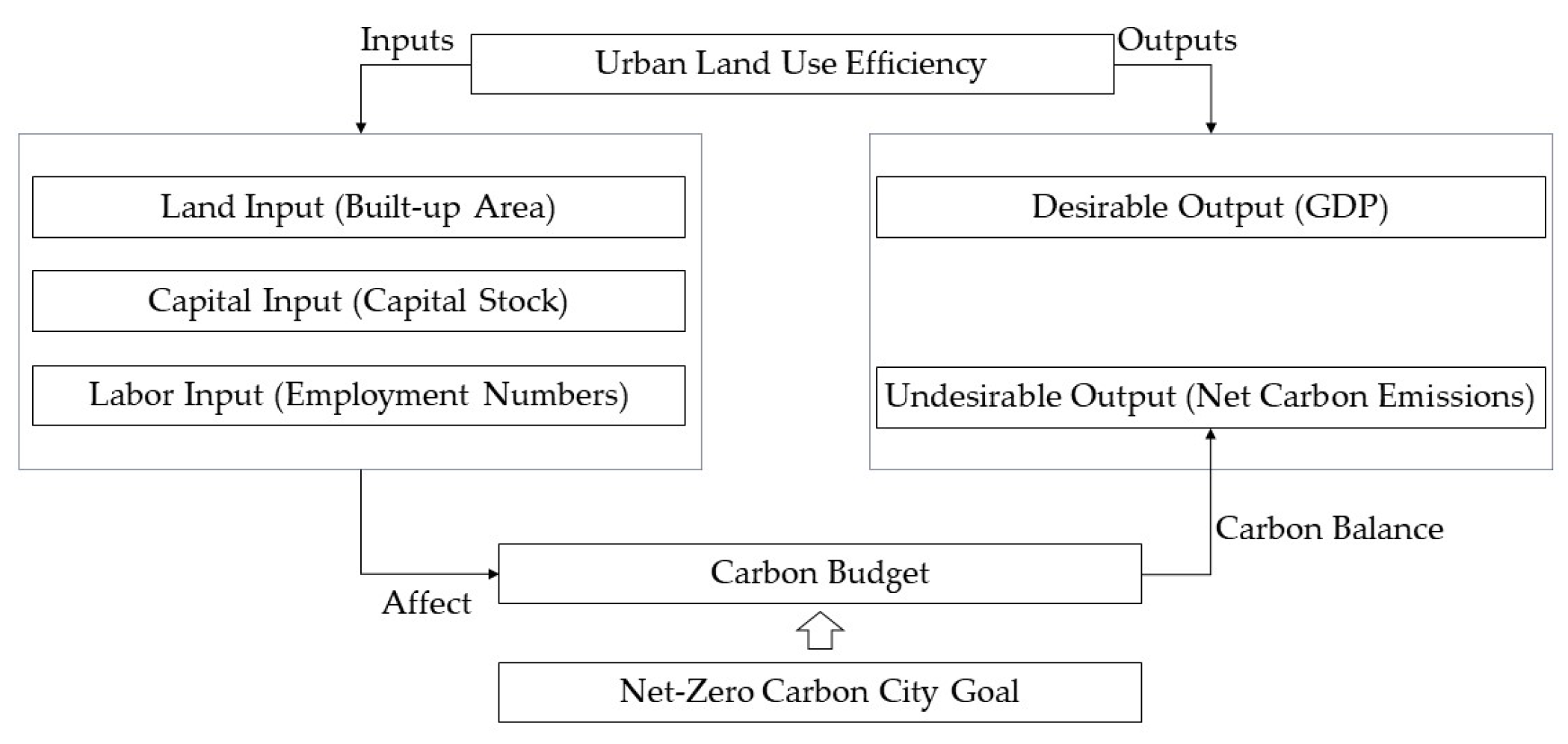

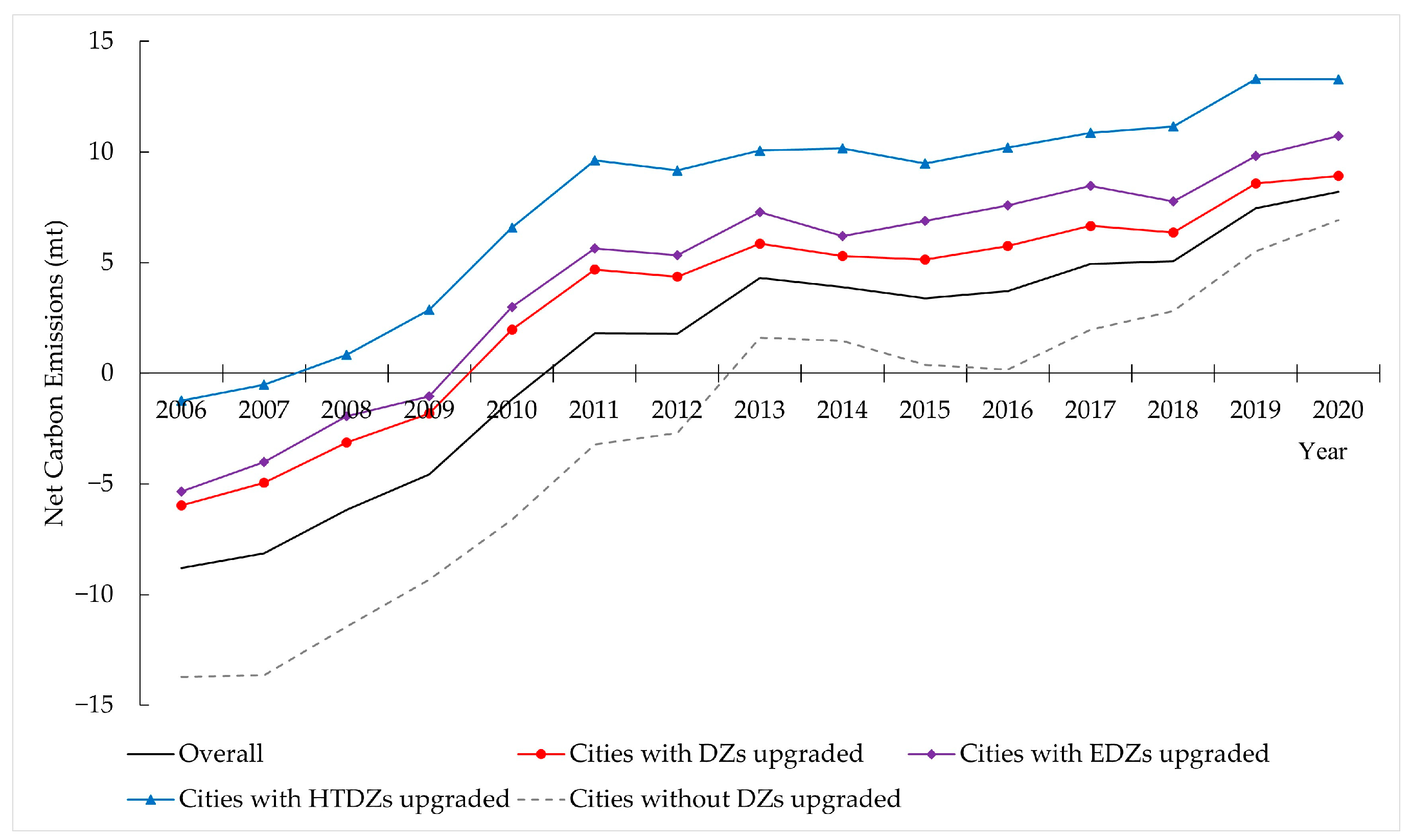
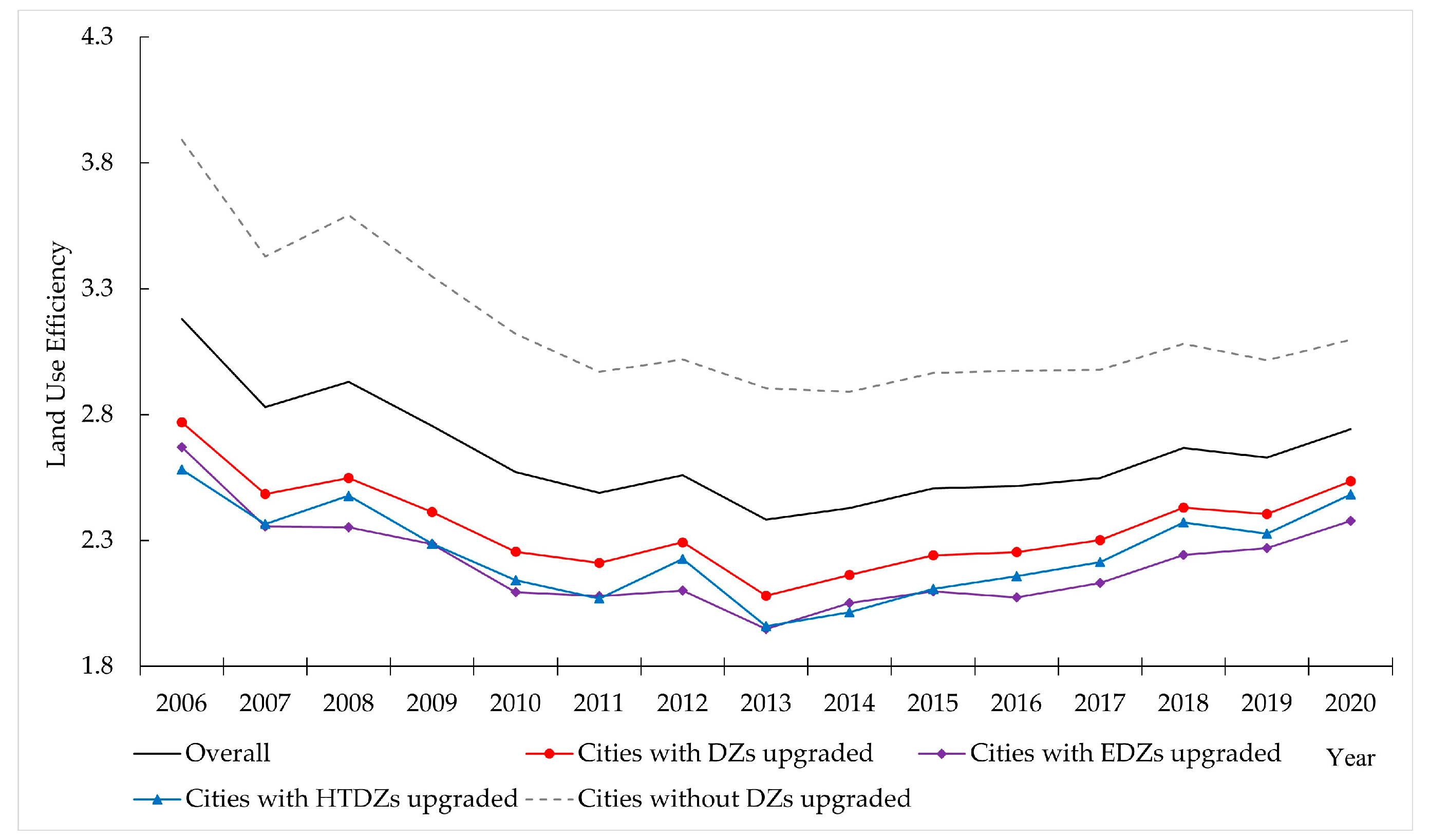
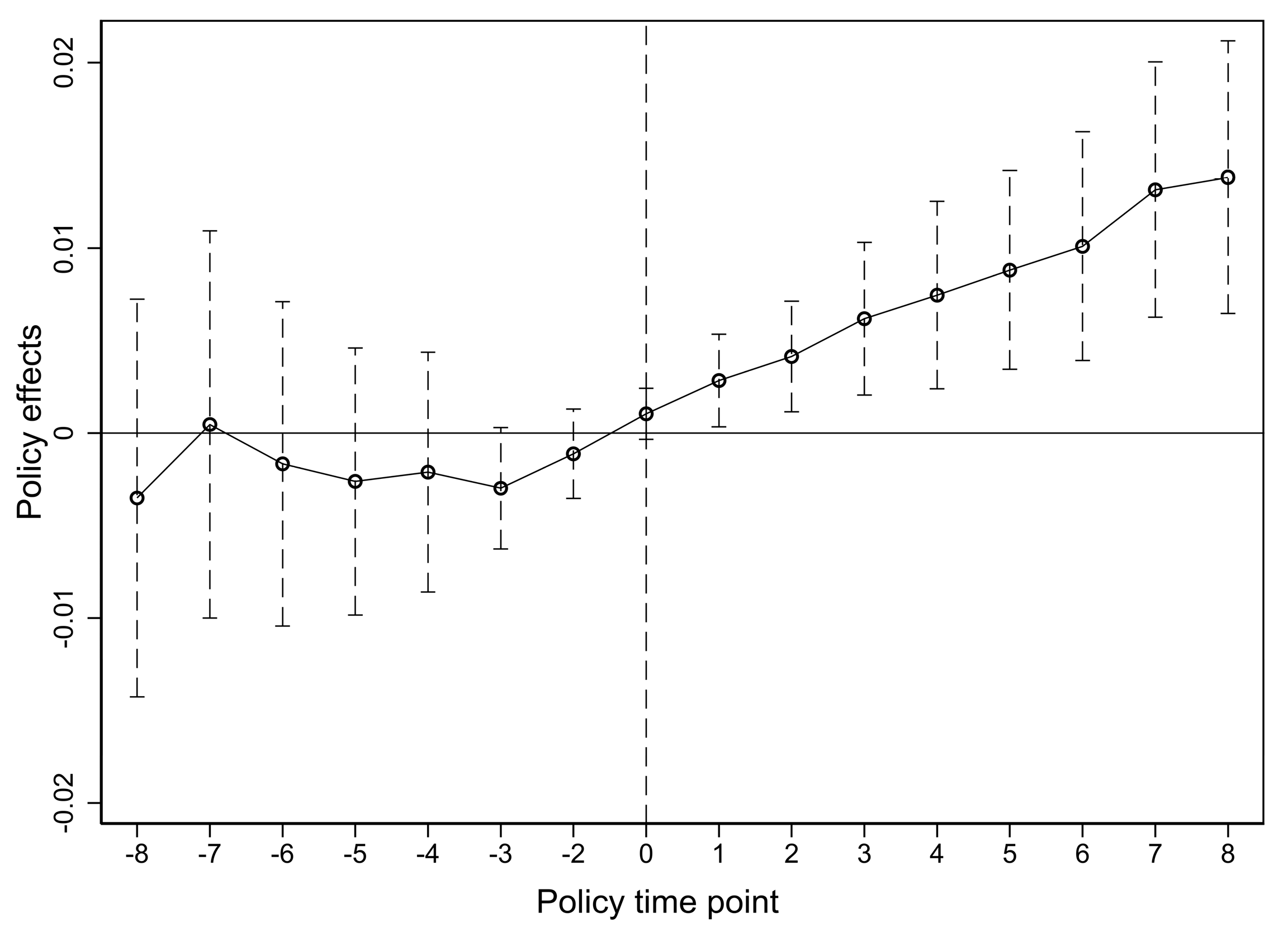
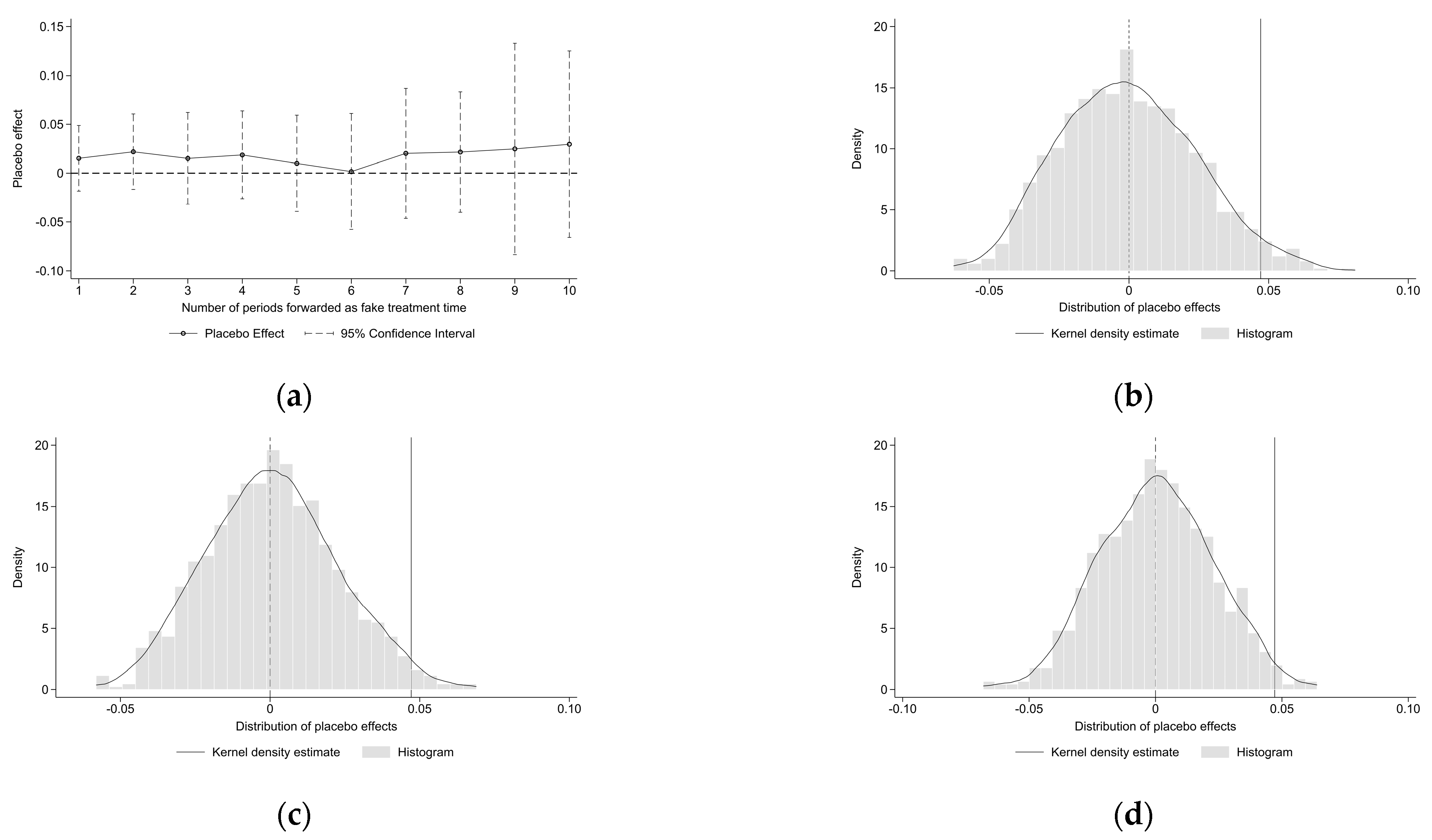
| Layer of Criteria | Layer of Factors | Layer of Indicators | Unit |
|---|---|---|---|
| inputs | labor | number of employees in the primary, secondary, and tertiary | 104 persons |
| land | area of built districts | km2 | |
| capital | capital stock | 108 CNY | |
| outputs | desirable output | GDP | 108 CNY |
| undesirable output | net carbon emissions | million tones (mt) |
| Variable | Definition | Code | Unit |
|---|---|---|---|
| economic development | natural logarithm of GDP per capita | Pgdp | - |
| government intervention | (local fiscal expenditure)/regional GDP | Gov | % |
| financial development | deposits and loans of financial institutions/regional GDP | Fin | % |
| industrial structure | secondary and tertiary industry added value/regional GDP | Indus | % |
| foreign direct investment | number of foreign-invested enterprises/number of industrial enterprises | Fdi | % |
| number of provincial DZs | natural logarithm of number of provincial DZs | Num | - |
| ULUE | ||
|---|---|---|
| (1) | (2) | |
| UPDZ | 0.053 ** (0.024) | 0.047 *** (0.011) |
| control variables | no | yes |
| constant term | yes | yes |
| time fixed effect | yes | yes |
| city fixed effect | yes | yes |
| sample size | 2639 | 2639 |
| R-squared | 0.009 | 0.011 |
| ULUE | ||
|---|---|---|
| (1) | (2) | |
| UPDZ | 0.043 *** (0.014) | 0.045 *** (0.016) |
| control variables | no | yes |
| time fixed effect | yes | yes |
| city fixed effect | yes | yes |
| Panel A: Robust Estimations | ULUE | |||
|---|---|---|---|---|
| Simple Weighted ATT | Dynamic ATT | Calendar ATT | Group ATT | |
| (1) | (2) | (3) | (4) | |
| Simple ATT | 0.041 ** (0.019) | |||
| Pre_Avg | 0.007 (0.005) | |||
| Post_avg | 0.054 ** (0.025) | |||
| CAverage | 0.034 ** (0.014) | |||
| GAverage | 0.032 ** (0.014) | |||
| Panel B: Decomposed estimations | Estimated coefficient | Weight | ||
| Earlier treatment vs. Later control | 0.043 | 0.241 | ||
| Later treatment vs. Earlier control | −0.015 | 0.073 | ||
| Treatment vs. Never treated | 0.064 | 0.686 | ||
| Weighted coefficient | 0.053 | |||
| CE | CS | |||
|---|---|---|---|---|
| (1) | (2) | (3) | (4) | |
| UPDZ | −0.092 *** (0.029) | −0.083 *** (0.029) | 0.003 ** (0.001) | 0.003 ** (0.001) |
| control variables | no | yes | no | yes |
| constant term | yes | yes | yes | yes |
| time fixed effect | yes | yes | yes | yes |
| city fixed effect | yes | yes | yes | yes |
| sample size | 2639 | 2639 | 2639 | 2639 |
| R-squared | 0.039 | 0.044 | 0.002 | 0.011 |
| LR | ER | |||
|---|---|---|---|---|
| (1) | (2) | (3) | (4) | |
| UPDZ | −0.095 *** (0.037) | −0.093 ** (0.037) | 0.251 *** (0.065) | 0.129 ** (0.065) |
| control variables | no | yes | no | yes |
| constant term | yes | yes | yes | yes |
| time fixed effect | yes | yes | yes | yes |
| city fixed effect | yes | yes | yes | yes |
| sample size | 2028 | 2018 | 2421 | 2383 |
| R-squared | 0.040 | 0.030 | 0.691 | 0.644 |
| RM | SO | |||
|---|---|---|---|---|
| (1) | (2) | (3) | (4) | |
| UPDZ | −0.020 *** (0.006) | −0.028 *** (0.006) | 0.018 ** (0.008) | 0.014 *** (0.005) |
| control variables | no | yes | yes | yes |
| constant term | yes | yes | yes | yes |
| time fixed effect | yes | yes | yes | yes |
| city fixed effect | yes | yes | yes | yes |
| sample size | 2421 | 2383 | 2024 | 2018 |
| R-squared | 0.047 | 0.199 | 0.033 | 0.038 |
| TI | GTI | |||
|---|---|---|---|---|
| (1) | (2) | (3) | (4) | |
| UPDZ | 0.062 ** (0.030) | 0.105 *** (0.029) | 0.153 *** (0.037) | 0.155 *** (0.037) |
| control variables | no | yes | no | yes |
| constant term | yes | yes | yes | yes |
| time fixed effect | yes | yes | yes | yes |
| city fixed effect | yes | yes | yes | yes |
| sample size | 2421 | 2383 | 2421 | 2383 |
| R-squared | 0.400 | 0.460 | 0.467 | 0.532 |
| ULUE | ||
|---|---|---|
| EDZ | HTDZ | |
| (1) | (2) | |
| UPDZ | 0.034 ** (0.017) | 0.076 *** (0.015) |
| control variables | yes | yes |
| constant term | yes | yes |
| time fixed effect | yes | yes |
| city fixed effect | yes | yes |
| sample size | 1651 | 1586 |
| R-squared | 0.014 | 0.013 |
| ULUE | |||
|---|---|---|---|
| Eastern | Central | Western | |
| (1) | (2) | (3) | |
| UPDZ | 0.023 *** (0.007) | 0.087 *** (0.018) | 0.003 (0.030) |
| control variables | yes | yes | yes |
| constant term | yes | yes | yes |
| time fixed effect | yes | yes | yes |
| city fixed effect | yes | yes | yes |
| sample size | 793 | 1092 | 754 |
| R-squared | 0.025 | 0.001 | 0.013 |
Disclaimer/Publisher’s Note: The statements, opinions and data contained in all publications are solely those of the individual author(s) and contributor(s) and not of MDPI and/or the editor(s). MDPI and/or the editor(s) disclaim responsibility for any injury to people or property resulting from any ideas, methods, instructions or products referred to in the content. |
© 2024 by the authors. Licensee MDPI, Basel, Switzerland. This article is an open access article distributed under the terms and conditions of the Creative Commons Attribution (CC BY) license (https://creativecommons.org/licenses/by/4.0/).
Share and Cite
Rao, J.; Zhang, X.; Zhai, D. Does the Upgrading of Development Zones Improve Land Use Efficiency under the Net-Zero Carbon City Goal? Prefectural-Level Evidence from Quasi-Natural Experiments in China. Land 2024, 13, 1245. https://doi.org/10.3390/land13081245
Rao J, Zhang X, Zhai D. Does the Upgrading of Development Zones Improve Land Use Efficiency under the Net-Zero Carbon City Goal? Prefectural-Level Evidence from Quasi-Natural Experiments in China. Land. 2024; 13(8):1245. https://doi.org/10.3390/land13081245
Chicago/Turabian StyleRao, Jinguo, Xiaosong Zhang, and Duanqiang Zhai. 2024. "Does the Upgrading of Development Zones Improve Land Use Efficiency under the Net-Zero Carbon City Goal? Prefectural-Level Evidence from Quasi-Natural Experiments in China" Land 13, no. 8: 1245. https://doi.org/10.3390/land13081245






